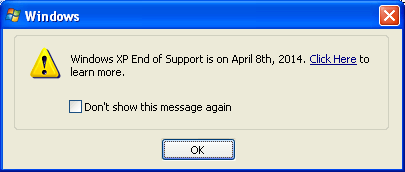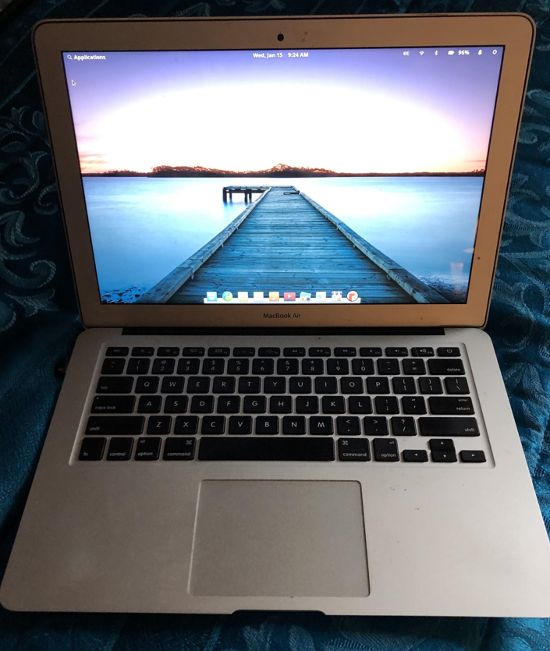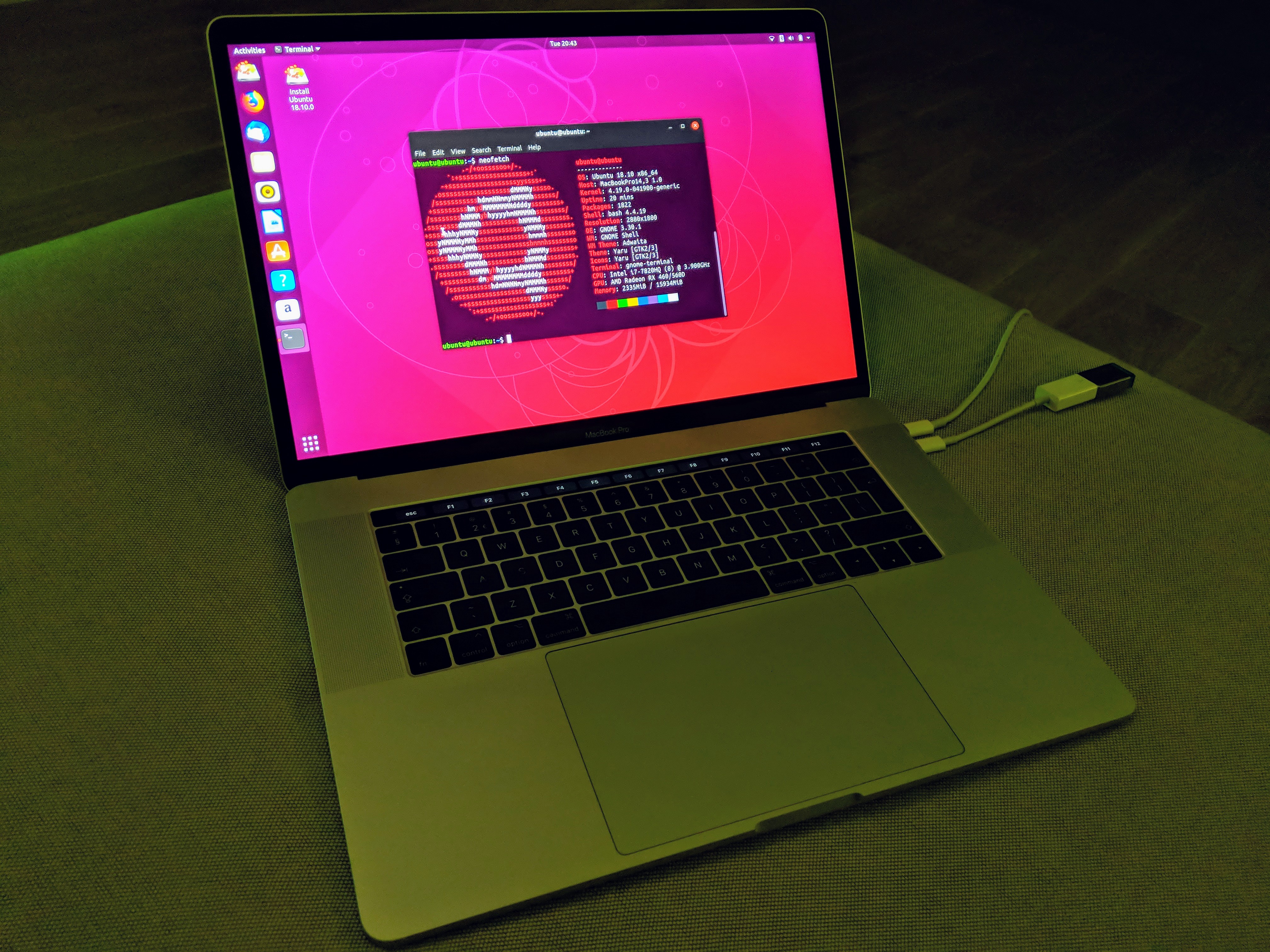Best Linux For Macbook Pro
Author: Michael Minn (www.michaelminn.com)
- Best Linux Distro For Macbook Pro 2015
- Best Linux For Macbook Pro 2009
- Best Linux For Macbook Pro 2012
21 January 2017
Describes how to set up an Debian 8.7 (Jesse) operating system on aMacBook Pro 8.2 Computer
1. Introduction
This page describes how to install aDebian 8.7 (Jesse) Linux operating systemon a MacBook Pro 8.2 notebook computer.
Hello, I got an old MacBook Pro, I can't say which one exactly but early 2011 or 2012. It is starting to feel kind of sluggish (not so weird seeing the age), but I've decided I now want to install Linux on it instead (I've just done the same process for my Windows PC). For MacBook Pro 13 (7,1) (Obsolete with squeeze) Current installer can not install. But you can use Iwamatsu's D-I. For MacBook Pro 13 (8,1) First of all, it is important that you read carefully the MacBook Install Section of Debian Wiki, so that you can prepare your Macbook Pro, and understand the terms needed for proceeding with the installation. The MacBook Pro is a popular platform for running Linux. Under the hood, Mac's hardware is remarkably similar to most of the parts used in modern Windows computers. You'll find the same processor families, graphics engines, networking chips, and a great deal more.
Linux will run fine on this machine, although there are somequirks that make installation a bit of a challenge. Most notableis the presence of two video chips on this machine, which requiressome cryptic file editing.
- The main steps to install Linux Mint on your PC or Mac are as follows: Prepare an installer. This is typically a USB drive, although you can also burn it to an optical disc if you're old school. Note however that most Linux installers these days are larger than a CD-ROM (700 MB), so you'll need a DVD-R/RW or a thumb drive of the appropriate size.
- As a new user in the world of Apple computers and laptops, I am trying to understand better why it is a pain in the ass to boot a flavor of Linux using an Apple MacBook. I know from what I have seen that it is possible in older models, so I gave it a shot myself. My setup is a MacBook Pro 13 inch 2020 and Ubuntu is installed on an external SSD.
- Intel Core i7-2635QM 2.0 GHz Processor (4-core, 8-thread)
- 6 MB SmartCache
- 4GB (two 2GB SO-DIMMs) of 1333MHz DDR3 memory; two SO-DIMM slots support up to 8GB
- 500.11 GB (5400 RPM) Toshiba MK5065GSF SATA hard drive
- 8x slot-loading SuperDrive (DVD+-R DL/DVD+-RW/CD-RW)
- 15.4-inch diagonal 1440 x 900 WXGA+ LED-backlit glossy widescreen display
- Two video chips:
- Intel HD Graphics 3000 384 MB
- AMD Radeon HD 6400M/7400M Series VGA compatible controller
- Two USB ports
- MagSafe power port
- FireWire 800 port (up to 800 Mbps)
- Two USB 2.0 ports (up to 480 Mbps)
- Thunderbolt port (up to 10 Gbps)
- Audio line in
- Audio line out
- Kensington lock slot
- Gigabit Ethernet port, Broadcom NetXtreme BCM57765 Gigabit Ethernet PCIi (rev 10)
- SDXC card slot, Broadcom BCM57765/57785 SDXC/MMC Card Reader (rev 02)
- Broadcom BCM4331 802.11a/b/g/n (rev 02)
- Webcam and Microphone
- 78-key US keyboard
- Multi-Touch trackpad
- Dimensions: 14.35 in. x 9.82 in. x 0.95 in.
- Weight: 5.6 pounds
- Manufactured late 2011
2. Network Install
These instructions largely follow theDebian MacBook Proinstallation instructions. You will need a wired Ethernet connection.
Clean OS X: I got this machine used, so the first thing I did waswipe the hard driveand perform a clean install of Mac OS X 10.11 (El Capitan).

Create Network Install Thumb Drive: If you have anexisting Linux box, you can download network install image and copy it to a USB drive.No exotic third party utilities are necessary, although note thatit is being copied directly to the disk device rather than a mounted filesystem:
Boot into Internet Recovery Mode: Holding downOption + Command + R on boot will put you in Internet recovery mode,which will allow you to split the partition.
The first challenge is that Mac OS X is installed with CoreStoragephysical volumes, that must be reverted first. Open a terminal (Utilities -> Terminal) andlist the volumes:
When you have the core storage volume name you can revert. Thisis the volume name on my machine:
You can then start the Utilities -> Disk Utility, select the diskand resize the partition. I resized it to half so the Mac side would still be useful.

Boot the thumb drive: Place the bootable thumb drive into a slot and reboot,Holding down the Option key, which will cause an EFI Boot into the network installer.
Installation Options: The following are the installation options I chose:
/MacBook-Air-vs-MacBook-Pro-ae0bc74928fe43c397814d29b6ea35ad.jpg)
- Language (English)
- Location (USA)
- Keymap (American English)
- Non-free firmware: This is needed Broadcom wireless chip firmware (b43/ucode29_mimo.fw ...). It is easiest to skip this and do it lateronce the OS is installed
- Hostname (your choice of an arbitrary name)
- Domain name (localhost)
- Root password (write this down somewhere safe)
- Real name (you may want to give something fake to preserve privacy)
- User name (your choice)
- User password (your choice)
- Time zone (your choice)
Guided Disk Partition: This is what I chose:
Base System Install: Took me about 6 minutes
Main Install: This is the first of the tricky parts,since you need to avoid installing a desktop so you can deal withthe graphics chip issue manually:
Best Linux Distro For Macbook Pro 2015
- Select a mirror (your choice)
- Popularity contest (NO)
- Software selection (NO debian desktop, standard system utilities)
- DO NOT INSTALL A DESKTOP
The install ran about 45 minutes
Install Software: The network install misses some importantpackages you will need. Log in as root and install:
Video Chip Disable: If you do an ordinary boot with thismachine, the boot will complete, but the display will show onlya blinking cursor. This trick was gleaned fromthis ArchLinux install page.
To disable the second chip, you need to add the following outblines to the /etc/grub.d/00_header file immediatelyafter the set gfxmode... line:
outb() does low-level port output and writes to the video controller.
Then update grub:
reboot by pressing the power button to shutdown.
3. Wireless
The Broadcom 4331 wireless works fine, but you have to install some firmware.
Best Linux For Macbook Pro 2009
Add the following repository to /etc/apt/sources.list:
Install the firmware package:
After you reboot, wlan0 will be available. Some commands:
WPA encrypted networks require the wpa_passphrase utility:
4. Removing systemd
systemd is an init system that bootstraps user space and managesprocesses. It has largely replaced the UNIX System V init systems on mostdistributions, with the objective of unifying basic Linux configurations acrossdistributions. systemd has provoked considerable controversy because of itscomplexity and violation of fundamental Unix dependency philosophy.
It is actually fairly easy to remove and replace with classic Sys V,as described in these instructions. As with any major system change,full backup is recommended before proceeding.
- Install the System V init packages:
- Copy the new inittab booting run level file:
- Add this line to /etc/default/grub with this line (not sure this is necessary):
- Update the GRUB bootloader:
- Reboot
- Remove the systemd package:
- Create the /etc/apt/preferences.d/systemd fileand add these lines to it:
- Verify systemd is gone from your system. It is an insidiouspackage that is a bit difficult to confirm is gone:
5. Removing the Desktop
If you're hard core command line and don't want the clutter and delay of thea desktop, you might consider getting rid of the desktop altogether andjust using a window manager to manage xterms and X applications started fromthe xterms. This will speed your boot time a bit and get rid of some annoyingbackground daemons.
IceWM: Although I used the venerable Motif Window Manager (MWM) for a number of years (from the motif-clients package), this version of mwm locks up whenX is started. So I switched to the ICE Window Manager,which has a few more features (like a task bar with graphical system monitoring)but is still fast and lightweight:
.xinitrc is a file that is executed when X is started. Create a .xinitrc in your home directory (/home/<username>) and type thefollowing lines. This creates a couple single terminal window, sets the 'desktop' color to pleasant shade of greenish grey blue and startsthe window manager. When you type 'startx', from the text login, it will start an xterm, in which you can type commands to start other programs. You can create additional terminal windows from a popup menu when you right-click on the desktop.
I found the full brightness to be a bit much, especially in contrast to older, dimmer LCD displays. The backlight doesn't seem to be accessible through ACPI, but the xgamma command adjusts midtones (gamma) and warms things up a bit, although this is optional.
PulseAudio is a nasty sound server that adds latency and eats up CPU. If you don't have the desktop you can ditch it.
However, you will need to deal with protections set up for ALSA that willkeep your applications from being able to access the sound devices. Add yourselfto the audio group:
Configure GRUB for terminal mode start:It is helpful to see what is goin on during boot rather than have bootmessages hidden behind the splash bitmap just in case there's a boot problem(which used to happen alot). Adding this line to the /etc/default/grubfile will cause the machine to boot in console mode:
Then run:
After these changes, on boot you will see the system startup messagesand then be greeted with a console login prompt. After logging in, youcan use the startx command to start the graphical desktop.
6. Webcam
The webcam is /dev/video0 and you can look at yourself with:
To access the camera, you need to add yourself to the video group:
7. TrueType Fonts
The X window server supports TrueType (tm) fonts, although installing them via the command line is a bit more cumbersomethan with an installer program or package. If you've got some on a Windoze box, TrueType fonts tend to look quite a bit better than the fonts that come with the distributions. And if you're doing any web development, you need them to have at least a guess as to whatyour pages look like on a Windoze box.
Unfortunately, the FontPath configuration that specifies the directorieswhere fonts are located is compiled into the X binary and is not configurable.While 'xset +fp' can add a directory to the font path, that setting is not permanent and is lost when you reboot. xset cannot be added to a local configuration file like .xinitrc. This is not a problem for newer applications that use fontconfig,but this may represent an issue for older applications that only usethe X font paths. The kludge is to copy the fonts you want to add into one of the configured truetype font directories.
Copy the fonts into a shared font directory: You can do an 'xset -q'to find the configured Font Paths for your X configuration:
Chose one of the directories listed in 'Font Path'and copy your .ttf font files into that directory. In my case, I chose to use/usr/share/fonts/X11/misc. While you could create a new directory under /usr/share/fonts, fonts installed there would not be visible to xlsfonts or older X applications.
Then run mkfontscale to create the fonts.scale file andmkfontdir to create the fonts.dir files used by the X server. You should also change the owner of all the files to root to avoid permission problems. The mkfontscale and mkfontdir steps are critical if you want to be able to list your fonts with xlsfonts or other legacy X applications.
You can check to verify the fonts are loading by startingan X application (like gimp). The xlsfonts command lists fontsavailable directly from X and the fc-list command lists fontsavailable through fontconfig.
The listing will likely be long, but if the fonts are loadingcorrectly, you will see X font names like these (for Arial andGaramond, respectively):
You can bitch all you want about the Yankees and greed but they spend money in a sincere effort to win it all, every year. What fan wouldn't want their teams to do that.(Curt Schilling)
Another prerequisite you did not mention was to create a partition and format it for Linux: Partition a physical disk in Disk Utility on Mac - Apple Support

The most likely explanation is that Linux won't recognize APFS. It sounds like you already addressed Secure Boot / External Boot but confirm those requirements.
I don't believe there is any reason for concern about overheating. Macs implement thermal protection in hardware.
I'm not sure deactivating SIP is required. It's strictly to prevent modification of macOS. Leave it disabled if you wish but if and when you get Linux installed you should enable it again.
Best Linux For Macbook Pro 2012
Jan 30, 2020 11:02 AM